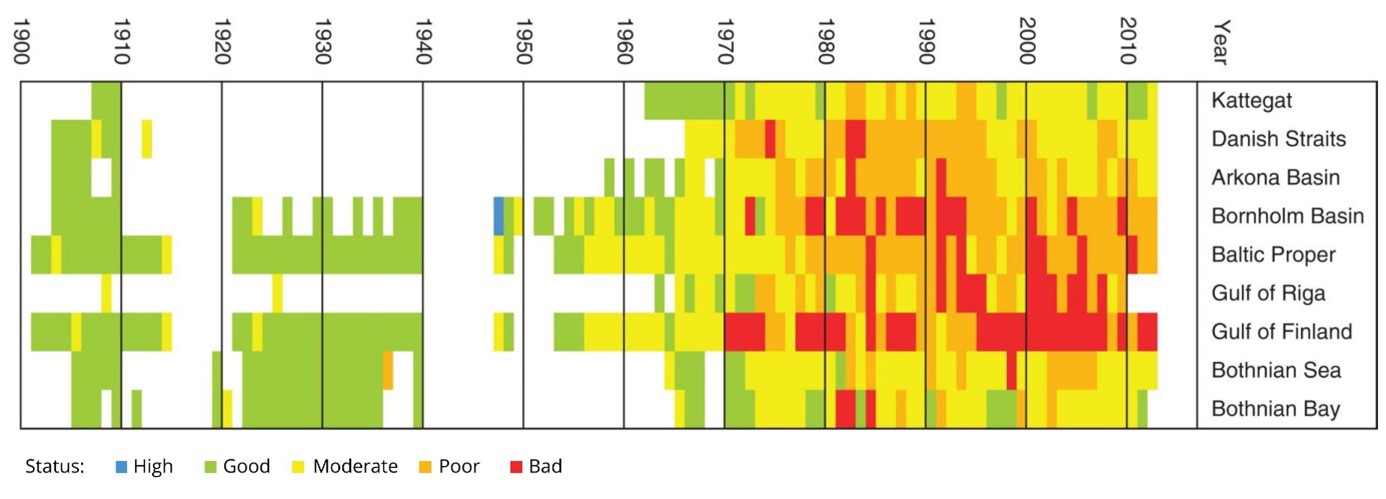





The Baltic Sea, compared to other seas and oceans, is a relatively shallow, almost inland water body in the heart of Europe, the geographic location, history and prospects of climate change make it a very specific sea. Monitoring of the hydrographic conditions of our sea allows us to verify its variability over time and assess its condition.
The future of the inhabitants of the Baltic Sea basin is inextricably linked with the future of the sea itself. Nearly 100 million people live by the Baltic Sea, whose activities affect the state of the waters of our sea. We call it anthropopressure. Industrial and agricultural activities and the associated huge loads of nutrients reaching sea waters are just some of the elements influencing the quality of the Baltic Sea. One of the features influencing the assessment of the state of our sea’s waters are hydrographic conditions, including: salinity, temperature, sea currents and waves. Data on them are part of the strategic document prepared by PGW Waters Polskie – the sea water protection program and its update.
Is the Baltic Sea salty enough?
The amount of salt dissolved in the waters of the Baltic Sea is small compared to other seas. The average salinity of our sea ranges from 7-8 per mille in the vicinity of Denmark to only 3 in the north, between Finland and Sweden. When going on a trip to the Adriatic Sea or the Black Sea, we will immediately feel the difference. Foreign, much saltier waters will make us feel stinging or dry skin. For comparison, the average salinity of the Mediterranean Sea is as high as 39 per mille.
The salinity of the Baltic Sea is strictly dependent on the water exchange with the North Sea, which in the case of the Baltic Sea is difficult due to the narrow and tight connection enabling water exchange due to the presence of the Danish Straits. The infusions of salty waters from the North Sea are beneficial, because the colder, better oxygenated water from the ocean provides fresh oxygen, so much needed by the Baltic Sea, which often suffers from its deficit. Unfortunately, we observe that this water exchange occurs less and less frequently. In the 1970s and 1980s, it was about 5-7 infusions every 10 years. Meanwhile, only two have been found since 2000.
Oxygen deficiencies, huge amounts of fresh water coming in, and difficult exchange of waters with other reservoirs are just a few elements that bring us closer to the conclusion that over time our sea may turn into a reservoir more fresh than saltwater. Let us remember that fresh waters from over 200 rivers are pumped into the Baltic Sea every day. With limited water exchange with the North Sea, the degree of salinity in the Baltic Sea will decrease, and the problem of excessive eutrophication of its waters will increase.

The level of eutrophication of the Baltic Sea basins has significantly increased over the last 110 years. Source: https://doi.org/10.1111/brv.12221.
The Baltic Sea is getting warmer
The temperature of the waters of the Baltic Sea is an element that changes depending on the season. In summer, the temperature in the open sea usually does not exceed 20⁰C, and in winter it drops to around 2⁰C. Geographic location, eastern winds, bringing cool arctic-continental air or a characteristic rising current called upwelling are just some of the factors influencing the temperature variability of our sea.
In the latest issue of the IMWM Observer, we read that the temperature of the Baltic Sea undergoes noticeable changes over the years. Already in the period 1861-2000, the air temperature in the Baltic Sea basin increased by 0.11 ° C / 10 years (north of 60 ° N) and 0.08 ° C / 10 years (south of 60 ° N), while the global value is an increase of 0.05 ° C / 10 years. These figures show how much faster the Baltic Sea is warming compared to other waters. The local climate is created by the variability of the atmospheric circulation over the North Atlantic, which is manifested in the different intensity of the western runoff, as reflected by the NAO index. Its strongly positive values in the last twenty years of the twentieth century were responsible for warm and humid winters abundant with storms, which certainly did not help to slow down the process of water warming.
Rising water temperatures catalyze the eutrophication process, and warmer waters are able to absorb much less oxygen, contributing to the formation of dead zones in the sea. Higher water temperature also favors the development of microorganisms and algae, which results in problematic blooms of cyanobacteria, which pose a threat not only to marine ecosystems, but also a direct danger to people resting at the seaside.
Building and destructive forces shaping the shores of the Baltic Sea, i.e. waves and sea currents
Waves and sea currents are the eternal forces that shaped the shores of the Baltic Sea. Coastal lakes, such as Łebsko and Gardno, spits and shallows are selected examples of the building force, and landslides, cliffs or “taking beaches” – the destructive power of the Baltic Sea. Over the centuries, they allowed for the specific appearance of the Polish coast, and the hydrotechnical solutions used by engineers, such as breakwaters or spurs, are only selected structures aimed at limiting the force of the sea element, used to protect a given area or infrastructure.
The presence of waves visible to the naked eye and invisible currents in the water column at various depths is mainly the effect of the wind. In the area of the Polish coast, those blowing from the western sector prevail, bringing relatively warm and humid air masses to the Baltic Sea. It is also a direct cause of increased sums of precipitation in the coastal region, and therefore also the supply of fresh water to the basin.
Due to the progressive climate change, winds above 8⁰ on the Beaufort scale and the associated waves, even several meters high, are a phenomenon more and more frequent in the waters of the Baltic Sea. This dangerous phenomenon is also responsible for the so-called storm surges, which cause huge losses, especially in densely populated and highly urbanized areas, such as larger cities of the Polish coast. More information in the topic article Sea shield and hydrolologists from the Institute of Meteorology and Water Management.
Climate change will not bypass the Baltic Sea
According to the Water Law Act, the monitoring of the Baltic Sea is carried out by the Chief Inspectorate for Environmental Protection as part of the State Environmental Monitoring. Modeling of hydrodynamic processes is carried out by IMWM-PIB. The latest information on forecasts for the Baltic Sea is available here.
The scenarios of climate change in the Baltic Sea area clearly indicate an increase in the average annual air temperature in the 21st century – in the case of the best variant, it will rise from 1 ° C to 5 ° C. As for the Baltic Sea itself, the climate scenarios predict an increase in water temperature, a decrease in ice cover and a decrease in salinity of its waters as a result of increased rainfall and runoff. The seasonal pattern of the runoff will be modified by changes in precipitation and faster snow melting. You can read more about the future of the Baltic Sea in the light of climate change in the IMGW Observer in the article Can the Baltic Sea be a warm sea ?

Change (in relation to the period 1991-2020) in the values of air temperature (° C) and precipitation (%) for the Baltic Sea area (source: KNMI Climate Change Explorer, https://climexp.knmi.nl/plot_atlas_form.py).
Save the sea!
The program for the protection of marine waters contains a set of measures aimed primarily at improving the state of the environment of marine waters and achieving good status (GES), as well as increasing access to knowledge about individual elements of the environment. The condition assessment consists of 11 condition features and pressures, including hydrographic conditions. These elements are characterized by seasonal variability, and human activity may even cause a permanent change in these parameters. Limiting cumulative pressures on habitats, in particular benthic habitats, continuation of activities in the scope of establishing zones free from permanent anthropogenic interference in the spatial development plans of Polish sea areas and Natura 2000 protection plans are also activities aimed at improving the physical elements influencing the state of the Baltic Sea.
The activities included in the sea water protection program and its updating are carried out by various entities and ministries, but each of us can contribute to the achievement of the goal of a good condition of the Baltic Sea. We should remember that only effective cooperation of many units and organizations, as well as increasing the awareness of all inhabitants of our country about the importance of caring for the condition of our sea, will allow to improve the condition of the Baltic Sea and protect it properly, ensuring access to clean, biodiverse and safe sea waters. for future generations. Until October 5, 2021, 3-month public consultations on the draft update of the marine water protection program – aPOWM, last. Take part in project consultations and protect the sea with us!
